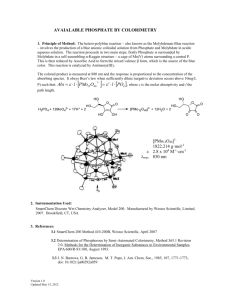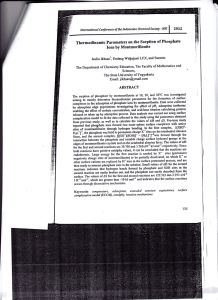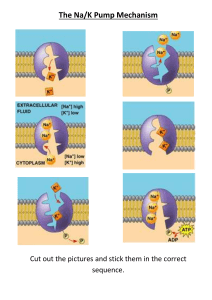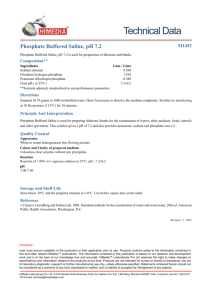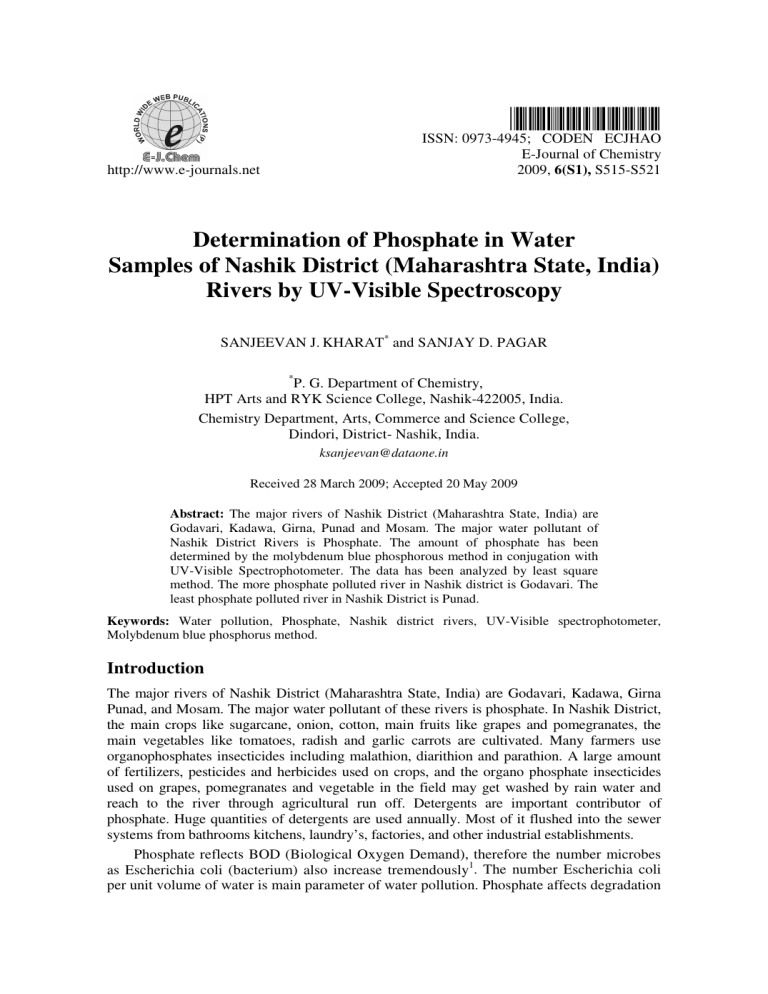
ISSN: 0973-4945; CODEN ECJHAO E-Journal of Chemistry 2009, 6(S1), S515-S521 http://www.e-journals.net Determination of Phosphate in Water Samples of Nashik District (Maharashtra State, India) Rivers by UV-Visible Spectroscopy SANJEEVAN J. KHARAT* and SANJAY D. PAGAR * P. G. Department of Chemistry, HPT Arts and RYK Science College, Nashik-422005, India. Chemistry Department, Arts, Commerce and Science College, Dindori, District- Nashik, India. ksanjeevan@dataone.in Received 28 March 2009; Accepted 20 May 2009 Abstract: The major rivers of Nashik District (Maharashtra State, India) are Godavari, Kadawa, Girna, Punad and Mosam. The major water pollutant of Nashik District Rivers is Phosphate. The amount of phosphate has been determined by the molybdenum blue phosphorous method in conjugation with UV-Visible Spectrophotometer. The data has been analyzed by least square method. The more phosphate polluted river in Nashik district is Godavari. The least phosphate polluted river in Nashik District is Punad. Keywords: Water pollution, Phosphate, Nashik district rivers, UV-Visible spectrophotometer, Molybdenum blue phosphorus method. Introduction The major rivers of Nashik District (Maharashtra State, India) are Godavari, Kadawa, Girna Punad, and Mosam. The major water pollutant of these rivers is phosphate. In Nashik District, the main crops like sugarcane, onion, cotton, main fruits like grapes and pomegranates, the main vegetables like tomatoes, radish and garlic carrots are cultivated. Many farmers use organophosphates insecticides including malathion, diarithion and parathion. A large amount of fertilizers, pesticides and herbicides used on crops, and the organo phosphate insecticides used on grapes, pomegranates and vegetable in the field may get washed by rain water and reach to the river through agricultural run off. Detergents are important contributor of phosphate. Huge quantities of detergents are used annually. Most of it flushed into the sewer systems from bathrooms kitchens, laundry’s, factories, and other industrial establishments. Phosphate reflects BOD (Biological Oxygen Demand), therefore the number microbes as Escherichia coli (bacterium) also increase tremendously1. The number Escherichia coli per unit volume of water is main parameter of water pollution. Phosphate affects degradation S516 S. J. KHARAT et al. lead to oxygen depletion which affects (and even kills) fish and other aquatic decomposing plants are known to produce toxins as strychnine which kills animals including cattle. Phosphate insecticides cause irreveversible inhibition of the enzyme chlorine steerage. These agents are absorbed by all routes including skin, mucosa, and symptoms and include weakness, blurred vision, headache, giddiness, nausea and pain in chest2. Organo phosphates may cause harmful effects on wild life. They affect calcium metabolism in birds, which affects egg lying with egg shells and consequently reproductive failure3. In the present study, the amount of phosphate present in the water samples of Nashik District rivers has been determined by the molybdenum blue phosphorous method in conjugation with UV-Visible Spectrophotometer4,5. Experimental 1. 2. 3. 4. Molybdate solution: 12.5 g of sodium molybdate (Na2 MoO4, 2H2O) was dissolved in 5 M H2SO4 and diluted to 500 mL with 5 M sulphuric acid (This is to be prepared fresh monthly 2.5 g Na2MoO4 2H2O dissolved in 5 M H2SO4 and diluted to 100 volumetric flask. Hydrazinium sulphate Solution: 0.15 g hydrazinium sulphate dissolved in deionised water and diluted to 100 mL volumetric flask. Potassium dihydrogen phosphate: Qualigens AR, purity > 95.5% Sulphuric acid: ( Qualigens, AR) Method The molybdenum blue phosphorous method in conjunction with UV-Visible spectrophotometer is a very sensitive method4,5 for the determination of phosphorus at 830 nm. Phosphate in the sample can be determined at sub-ppb concentration at 830 nm. Orthophosphate and molybdate ions condense in an acidic solution to form phosphomolybdic acid, upon selective reduction (e.g. with hydrazinium sulphate) a blue color is produced. The intensity of the blue color is proportional to the amount of phosphate initially incorporated into the heteropoly acid. If the acidity at the time of reduction is 0.5 M in sulphuric acid and hydrazinium sulphate is the reluctant then the resulting blue complex exhibits a maximum6 absorbance at 820-830 nm. Intensity of the color solutions is normally measured on a visible spectrophotometer. Field work Water samples of Godavari, Kadva, Girna, Mosam and Punad rivers were collected from eight different places. Water samples for analysis were taken from the collection sites in the month of April, in one liter capacity plastic bottles. Table 1 summaries the water sample collection sites of Godavari, Kadva, Girna, Mosam and Punad rivers. Calibration curve The calibration curve is necessary to establish a relationship between the absorbance and the phosphate content for spectrophotometer analysis. Standard 10 ppm phosphate solution was prepared by dissolving 0.04393 g of Analytical reagent potassium dihydrogen phosphate in deionized water and diluted to 1000 mL. From 10 ppm solution, the 25 ppb, 50 ppb, 75 ppb, 100 ppb, 125 ppb, 150 ppb, 175 ppb, 200 ppb, solutions were prepared. These solutions were prepared as per Table 2. The absorbance of standard solutions of KH2PO4 were measured by using Shimadzu UV-Visible (1700) spectrophotometer at 830 nm. The calibration curve is constructed by plotting absorbance values against concentration of standard solutions. The straight line graph passing through origin has been obtained. This confirms the validity of Beer’s – Lamberts law Table 1. Water Sample collection sites of various rivers of Nashik District. G1 G2 Someshwar Gangapur- gaon mandir K1 K2 G3 Asaramba-pu ashram K3 G4 Chopda launs K4 G5 G6 Panchavati Tapovan K6 G7 Janardhan swami K7 Lakmapur Avankhed Gi6 Gi7 G8 Saikheda gaon K8 Pimpalg-aon ketki Gi8 Hatoneregaon Nilvandigaon Padegaon Valkheda Gi1 Gi2 Gi3 Gi4 K5 Kadva molungi Gi5 Abhona Pale khudra Kalwan Bej Lohner Nimbola Agharkh Tehre M1 M2 M3 M4 M5 M6 M7 M8 Anatapur Taharabad Sompur Jaikheda Asakheda Nampur Ambasan Khakurdi P1 P2 P3 P4 P5 P6 P7 P8 Umbarg-aon Suphala Siddesh-war Savarpada Bhanadp-ada Desrane Mogbh-agni Bhadha-van Determination of Phosphate in Water Samples Sample Label Collection Site Godavari River Sample Label Collection Site Kadava River Sample Label Collection Site Girna River Sample Label Collection Site Mosam River Sample Label Collection Site Punad River S517 S518 S. J. KHARAT et al. Table 2. Preparation of standard phosphate solution. Volume of 10 ppm P 0.000 0.125 0.250 0.375 0.500 Final volume 50 50 50 50 50 Conc. of Phosphate, ppb 0 25 50 75 100 Volume of 10 ppm P 0.625 0.750 0.875 1.000 Final volume 50 50 50 50 Conc. of Phosphate, ppb 125 150 175 200 The slope of the line can be determined by using the equation. Slope = ∑ (x − x )(. y − y ) (x − x ) (1) 2 To calculate intercept of the line, the equation used is, Intercept = y − m x (2) x - mean value concentration. y - mean value absorbance. The absorbance of the solution can be expressed by straight line equation7 . Absorbance = (Slope × Concentration) + Intercept (3) Rearranging the equation (3), the concentration is expressed as Concentration = (Absorbance − Intercept) / slope (4) By using equation (4) we can calculate the amount of phosphate present in the solution. Least square method can be used to calculate value of slope and intercepts. Results and Discussion Table 3 shows the absorbance, amount phosphate determined by Shimadzu UV-Visible (1700) Spectrophotometer, and calculated by equation (4) of water samples of Godavari River. From Table 3, it is cleared that, the sample G8 shows the higher value of phosphate (191 ppb by spectrophotometer and 192 ppb by calculation). Sample G8 was collected from Saikheda Gaon. Sakhaida Gaon is 30 km away form the Nasik city. The higher concentration of phosphate at this site arises because of large industrial waste from Eklahara Thermal Power Station, and sewage, sludge water and water containing molasses form Nasik Sugar Factory. Phosphate level in the samples G1 to G8 increases. Table 3. Absorbance and concentration of phosphate (by Instrument and Calculation) of water samples of Godavari River. Water Samples G1 G2 G3 G4 G5 G6 G7 G8 Absorbance 0.122 0.130 0.135 0.141 0.162 0.166 0.169 0.192 Amount of Phosphate (By Instrument) 124.50 133.58 135.50 142.90 164. 28 168.20 170.12 191.20 Amount of Phosphate (Calculated) 122.2 130.2 135.2 141.2 162.2 166.2 169.2 192.2 Determination of Phosphate in Water Samples S519 The absorbance, amount phosphate determined by Shimadzu UV-Visible (1700) Spectrophotometer, and calculated by equation (4) of water samples of Kadva River are shown in the Table 4. From Table 4, it is cleared that the water sample K6 shows the higher value of phosphate (112.11 ppb by spectrophotometer and 111.2 ppb by calculation). The collection site of sample K6 is Lakhamapur Gaon. This collection site shows higher concentration of phosphate in water sample because of M.I.D.C. area of Lakhmapur which includes Seagram Distilleries, Everest Ceremics, and McDowell distillery. From these industries, wastage solid and liquid, sewage reach Kadwa river water. In Lakmapur village, large hectors of agriculture sector is also developed and it produces tones of grapes and vegetables. For the grapes and vegetable crops, farmers use oragnophosphate as well as phosphate fertilizers. Therefore in heavy rainy seasons precipitates come into the Kadva river basin and hence the collection site K6 shows higher concentration of phosphate. Table 4. Absorbance and concentration of phosphate (by Instrument and Calculation) of water samples of Kadva River. Water Samples K1 K2 K3 K4 K5 K6 K7 K8 Absorbance 0.081 0.084 0.089 0.091 0.104 0.111 0.092 0.093 Amount of Phosphate (By Instrument) 83.212 83.751 90.120 91.543 105.400 112.110 93.540 94.650 Amount of Phosphate ( Calculated) 81.2 84.2 89.2 91.2 104.2 111.2 92.2 93.2 The absorbance, amount phosphate determined by Shimadzu UV-Visible (1700) Spectrophotometer, and calculated by equation 4 of water samples of Girna River are given in the Table 5. From Table 5, it is clear that the sample Gi5 shows the higher value of phosphate (102.11 ppb by spectrophotometer and 101.2 ppb by calculation). The sample Gi5 was collected from the middle part of Girna river ( Lohner Gaon). At this site phosphate level in water sample is high because of Vasaka sugar factory at banking of Girna River. The polluted water with molasses of sugar factory dissolves in Girna river sides which contains higher concentration amount of phosphate. Girna River is less polluted as compared to Godavari and Kadwa. Table 5. Absorbance and concentration of phosphate (by Instrument and Calculation) of water samples of Girna River. Water Samples Gi1 Gi2 Gi3 Gi4 Gi5 Gi6 Gi7 Gi8 Absorbance 0.068 0.070 0.076 0.078 0.101 0.099 0.096 0.097 Amount of Phosphate (By Instrument) 69.840 71.0130 77.130 78.180 102.110 100.200 98.170 98.190 Amount of Phosphate (Calculated) 68.2 70.2 76.2 78.2 101.2 99.2 96.2 97.2 S520 S. J. KHARAT et al. Table 6 shows the absorbance, amount phosphate determined by Shimadzu UV-Visible (1700) Spectrophotometer, and calculated by equation 4 of water samples of Mosam River. From Table 6, it is understood that sample M7 shows the higher value of phosphate (79.170 ppb by spectrophotometer and 79.200 ppb by calculation). The sample M7 was collected from Ambasan Gaon. Ambasan Gaon is nearer to Nampur, sewage and sludge of Nampur village dissolves in Mosam River. Hence, the sample M7 shows the higher amount of phosphate. Mosam River is less polluted than Girna River. Table 6. Absorbance and concentration of phosphate (by Instrument and Calculation) of water samples of Mosam River. Water Samples M1 M2 M3 M4 M5 M6 M7 M8 Absorbance 0.055 0.062 0.063 0.068 0.077 0.078 0.079 0.078 Amount of Phosphate (By Instrument) 54.124 63.125 63.870 68.140 78.164 79.168 79.170 78.191 Amount of Phosphate (Calculated) 55.2 62.2 63.2 68.2 77.2 78.2 79.2 78.2 Table 7 presents the absorbance, amount phosphate determined by Shimadzu UVVisible (1700) Spectrophotometer, and calculated by equation 4 of water samples of Punad River. From Table 7, it is inferred that sample P 7 shows the higher value of phosphate (72.91 ppb by spectrophotometer and 70.2 ppb by calculation) The water sample P 7 was collected from Mogbhagni Gaon which is nearer to Kalwan. Because of agriculture sector of Kalvan Gaon, the sample P 7 shows higher concentration of phosphate. Punad River is less polluted than other rivers of the Nasik district. Comparative graph of higher amount of phosphate and the collection sites of higher polluted areas of various rivers of Nasik district is shown in Figure 1 Table 7. Absorbance and concentration of phosphate (by Instrument and Calculated) of water samples of Punad. Water Samples P1 P2 P3 P4 P5 P6 P7 P8 Absorbance 0.051 0.053 0.062 0.068 0.069 0.069 0.070 0.071 Amount of Phosphate (By Instrument) 52.12 54.63 63.87 68.14 68.16 69.74 72.91 71.19 Amount of Phosphate (Calculated) 52.2 53.2 62.2 68.2 69.2 69.2 70.2 71.2 Determination of Phosphate in Water Samples S521 250 200 191.2 Concentration 150 112.11 102.11 100 79.17 72.91 50 Punad Punad 88 Collection sites Mosam 6 Girna 5 Girna 5 Kadva66 Kadva Godavari Godavari 8 0 Figure 1. Comparative graph of higher amount of phosphate and the collection sites of higher polluted areas of various rivers of Nasik District. Conclusions 1. 2. Godavari river is largly polluted by phospahte than other rivers of the Nasik district while Punad River is less polluted. Decrease in order of phosphate pollution of Nashik district river is Gdavari > Kadva > Girna > Mosam > Punad Acknowledgement SDP thanks Dr. V. B. Gaikwad, Dean of Science faculty, Pune University, and Principal of KTHM College, Nashik for providing the Environmental Science Lab for experimental work. References 1. 2. 3. 4. 5. 6. 7. Odum E P, Foundation of Ecology. W. B. Sounders, Philadelphis, 1971. Higgihs I J and Burns R C, The Chemistry and Micobiology of pollutions London Academic Press, 1975. Pawar K R, 1st Ed., Environmental Awarness, Pune University, Nirali Publication, Pune, 2004, 5.1-5.8. Bassett J, Denny R C, Jeffery G H and Mendham J, Vogels Text Book of Quantitative Inorganic Analysis, 4th Ed., UK., 1979. APHA, AWWA, AND WEF, Standard methods for the Examination of Water and Wastewater, 19th Ed., Washington, DC, American Public Health Association, 1995. Pittman J J, Zhang H, Schroder J L and Payton M E, Soil Science and Plant Analysis, 2005, 36, 1641-1659. Hongg R and Ledolter J, Engineering Statistics Macmillan Publication, New York, 1987, 187-188. Physical Chemistry Hindawi Publishing Corporation http://www.hindawi.com International Journal of Journal of Advances in Volume 2013 Carbohydrate Chemistry Analytical Methods in Chemistry Hindawi Publishing Corporation http://www.hindawi.com Volume 2013 Hindawi Publishing Corporation http://www.hindawi.com International Journal of Inorganic Chemistry Volume 2013 Hindawi Publishing Corporation http://www.hindawi.com Volume 2013 The Scientific World Journal Hindawi Publishing Corporation http://www.hindawi.com Volume 2013 Analytical Chemistry Photoenergy Hindawi Publishing Corporation http://www.hindawi.com Hindawi Publishing Corporation http://www.hindawi.com International Journal of International Journal of Volume 2013 Volume 2013 International Journal of Electrochemistry Submit your manuscripts at http://www.hindawi.com Bioinorganic Chemistry and Applications Hindawi Publishing Corporation http://www.hindawi.com Hindawi Publishing Corporation http://www.hindawi.com Volume 2013 Volume 2013 Journal of Chemistry Chromatography Research International Hindawi Publishing Corporation http://www.hindawi.com Volume 2013 ISRN Inorganic Chemistry Hindawi Publishing Corporation http://www.hindawi.com Volume 2013 Hindawi Publishing Corporation http://www.hindawi.com Volume 2013 ISRN Organic Chemistry Hindawi Publishing Corporation http://www.hindawi.com Volume 2013 Journal of International Journal of Spectroscopy Hindawi Publishing Corporation http://www.hindawi.com Volume 2013 ISRN Physical Chemistry Hindawi Publishing Corporation http://www.hindawi.com Journal of Catalysts Spectroscopy Volume 2013 Hindawi Publishing Corporation http://www.hindawi.com Volume 2013 Volume 2013 ISRN Analytical Chemistry ISRN Chromatography Hindawi Publishing Corporation http://www.hindawi.com Hindawi Publishing Corporation http://www.hindawi.com Volume 2013 Hindawi Publishing Corporation http://www.hindawi.com Volume 2013

